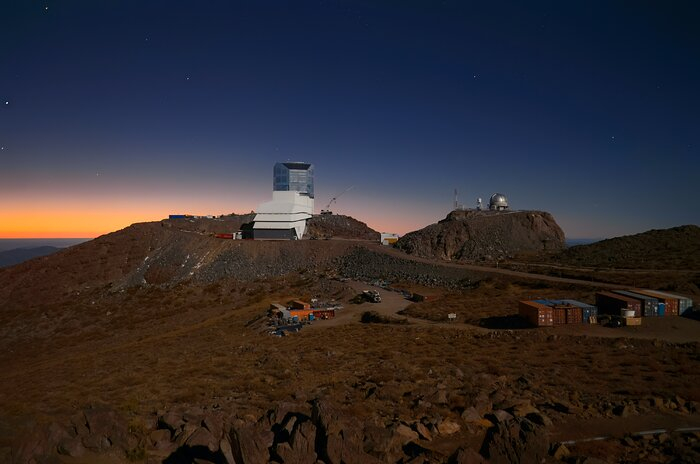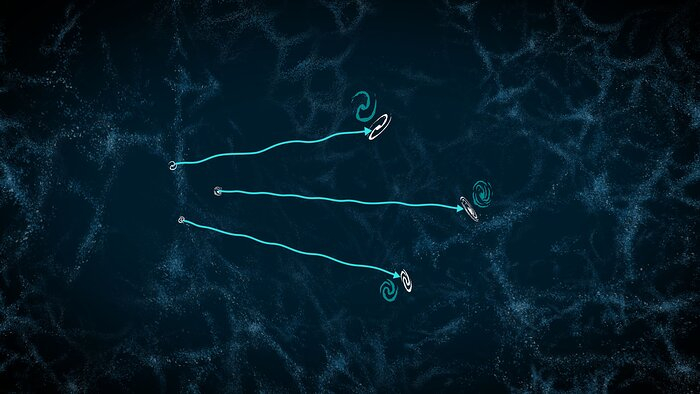The mysteries of the dark universe could be solved by the Rubin Observatory
With its Legacy Survey of Space and Time, the new observatory is expected to build the most precise map of the universe — ever.

A pioneering new observatory that will build the most precise map of the universe ever could, in the process, solve two of science’s most pressing mysteries: The nature of dark energy and dark matter . Collectively, these components make up what's known as the dark universe.
The Vera C. Rubin observatory is currently under development on the El Peñón peak of Cerro Pachón mountain in Chile and is set to begin operations in 2025. When it does, Rubin will conduct the Legacy Survey of Space and Time (LSST), observing the entire visible southern sky every few nights over 10 years. It will capture up to 1000 images of the sky on each one of those nights, giving scientists an exciting new view of the universe and insights into how it has evolved.
As it does this, Rubin's wide field-of-view will reveal how a web of dark matter distorts images of distant galaxies, which will allow scientists to better map the mysterious substance. And, because that large-scale cosmic web seemingly draws galaxies together while dark energy acts to push them apart, this could reveal details of this cosmic "tug-of-war" and, thus, how dark energy and dark matter have intertwined to shape the cosmos.
Related: Pulsar surprises astronomers with record-breaking gamma-rays
"With Rubin, we’re going to have everything," Andrés Alejandro Plazas Malagón, Rubin operations scientist, said in a statement. "We’re going to measure the properties of vastly more galaxies than what we have now, which is going to give us the statistical power to use weak lensing to both map the distribution of dark matter and study how dark energy evolves with time."
How Rubin could shed light on the dark universe
Dark matter and dark energy are challenging for researchers to study because even though they account for 95% of the total energy and matter content of the universe (dark matter represents 27% and dark energy represents 68%), they are essentially invisible to us. This means the stuff that makes up stars, planets, and everything around us on a day-to-day basis (including our bodies) accounts for just 5% of the content of the cosmos.
The reason dark matter can't be seen is that it does not interact with light. It can therefore only be inferred by its gravitational effects on light and "ordinary" matter we actually can see. Those gravitational effects, in fact, literally help hold the contents of galaxies together as they spin, a discovery made by American astronomer Vera C. Rubin, who lends her name to this revolutionary new observatory. And while dark matter internally holds galaxies together, those galaxies themselves also cluster together which means the material is spread out on a much larger scale, keeping the structure of our universe strong.
Get the Space.com Newsletter
Breaking space news, the latest updates on rocket launches, skywatching events and more!
Dark energy also acts on a larger scale, accelerating the expansion of the universe — pushing galaxies apart faster (and faster) while interacting with the very fabric of space and time.

"You can think of dark matter as trying to build the cosmic structures, while dark energy is actually trying to dilute them and push them apart," Plazas Malagón said.
The action of dark energy is described by the cosmological constant, but this has been described as "the worst theoretical prediction in the history of physics” by some scientists, a statement that really isn’t hyperbole, either. The theoretical value of the cosmological constant, as predicted by quantum field theory and accounting for all the particles in the universe, is greater than the value measured by astronomers making observations of the cosmos — by 120 orders of magnitude.
That is equivalent to measuring a bag of sugar and finding it to weigh 1 pound while the count of individual grains of sugar you made predicted it should weigh 10^120 pounds (1 followed by 120 zeroes).
Rubin could help nail down a precise value for the cosmological constant by better mapping the invisible, universe-spanning cosmic web of dark matter using a phenomenon called gravitational lensing, first predicted by Albert Einstein in his 1915 theory of general relativity,
General relativity suggests objects with mass have a "warping" effect on the fabric of the universe. The greater the mass, the more extreme the warping. And from this warping of spacetime, the concept of gravity arises.

When light passes one of these warps, or "dents," in spacetime, its path gets curved. This means that when an object of great mass sits between Earth and a distant light source, light from that background source can take paths around the intervening object that are curved to different extremes based on how closely they skim the intervening object itself. Sometimes, those paths lead to the light's source appearing magnified from our vantage point on Earth. The phenomenon is known as "gravitational lensing."
Dark matter also has mass; thus, it partakes in this bending of light despite the fact that the mysterious form of matter doesn’t itself interact with light. This effect has been used to determine that most galaxies are surrounded by a halo of dark matter.
In extreme cases called "strong lensing," the effect of curved spacetime can cause objects to appear multiple times in the same image or cause a background object to appear smeared or distorted. This can amplify that light, allowing distant and faint objects to be seen. There are, however, more subtle cases of gravitational lensing called "weak lensing" that are useful in their own right.
"If strong lensing is like looking through the bottom of a wine glass, weak lensing is like looking through a large, very subtly warped window," Theo Shutt, a Stanford University Ph.D. candidate, said in the statement.
Weak lensing can occur not just at the edges of strong lensing effects generated by a massive body (like a galaxy or star cluster) but also as a result of the large-scale cosmic web of dark matter believed to permeate the universe. This causes subtle distortions of distant galaxies that are typically too slight to be seen on their own, but are calculable when a cumulative warping effect on several at once is considered.
That ultimately means seeing weak lensing as the result of the universe’s dark matter web requires a large dataset of galaxies and a view of collective distortion across the sky.
That is where Rubin will come in.
With a huge field of view provided by its 8.4-meter telescope, equipped with the largest digital camera in the world, the observatory will be able to visualize huge patches of the sky and collect data about billions of galaxies and their shapes. In fact, Rubin could be so powerful that it has the potential to suggest evidence that dark matter and dark energy aren’t the right ingredients for the universe at all — and that a modified theory of gravity may be required to account for the cosmos we see around us.
"Dark energy is a concept that fits with the accepted theory of gravity within Einstein’s general theory of relativity, but Rubin and the LSST will also allow us to explore alternatives to that, which is incredibly exciting as well," Plazas Malagón concluded.
Join our Space Forums to keep talking space on the latest missions, night sky and more! And if you have a news tip, correction or comment, let us know at: community@space.com.

Robert Lea is a science journalist in the U.K. whose articles have been published in Physics World, New Scientist, Astronomy Magazine, All About Space, Newsweek and ZME Science. He also writes about science communication for Elsevier and the European Journal of Physics. Rob holds a bachelor of science degree in physics and astronomy from the U.K.’s Open University. Follow him on Twitter @sciencef1rst.
-
Questioner "Dark matter" sounds reasonable until you drill down into the details of evidence.Reply
Hypothesized "dark matter" does not respond to gravity anywhere within a galaxy.
1) the outer edge of DM doesn't migrate inward from DM's own massive gravity.
2) DM doesn't pile up around stars and planets and amplify their gravity.
3) DM isn't cascading into the central black hole of galaxies.
Actual matter and antimatter both respond to gravity, they have to, it's the shape of space-time.
Clear up your thought process from reflex bias to state the empiric, evidentiary fact that thus far there is only 'unexplained gravity'.
<<Content removed by moderator>>
It is your chance to discover something new & original. -
Unclear Engineer I tend to agree that the postulated dark matter can't be behaving the same as regular matter or we would not even be able to tell that there is something different going on compared to the gravity we expect from the matter we can see. If there was a constant ratio of dark matter to regular matter, then we would just think that regular matter weighs the same as the actual combination.Reply
So, your definition of the observation of apparent gravitational attraction from something we do not detect is fundamentally correct.
There is still argument over whether that is due to incorrect expectations for gravity from matter we can detect (i.e., alternate formulations of the physical law of gravity) or some sort of matter that we cannot detect. Having spent a lot of time looking and theorizing about what other form of matter could exist that we are not detecting - and coming up empty, so far - there is a lot of effort on reevaluating the law of gravity. And, that is as it should be. But, we do not seem to be making much progress on either, so far.
Unless the Rubin Telescope gives us a new insight that allows us to actually understand the underlying physics which we obviously do not understand right now, all the new data can do is to provide more precise data on the observed phenomena so that theorists can more finely tune the fudge factors in their theories.









